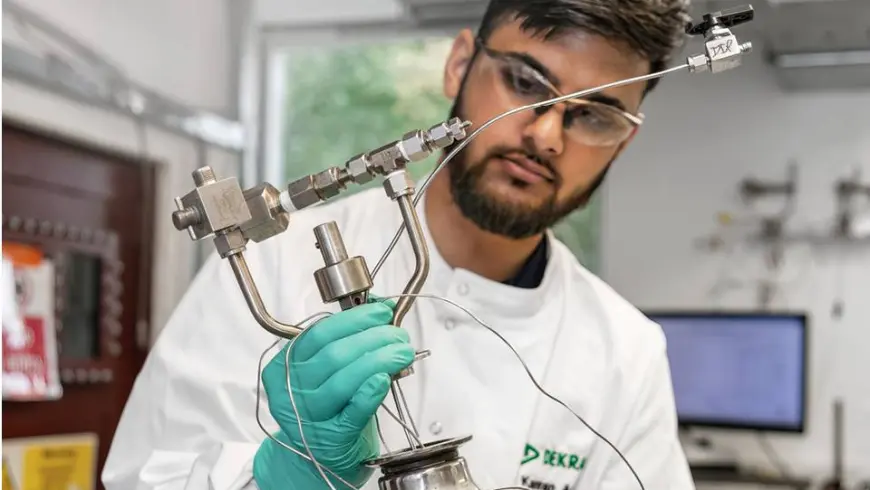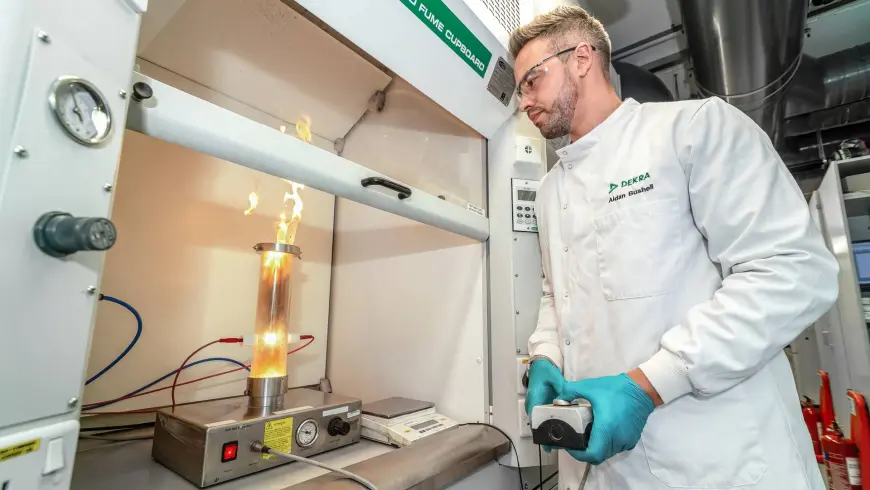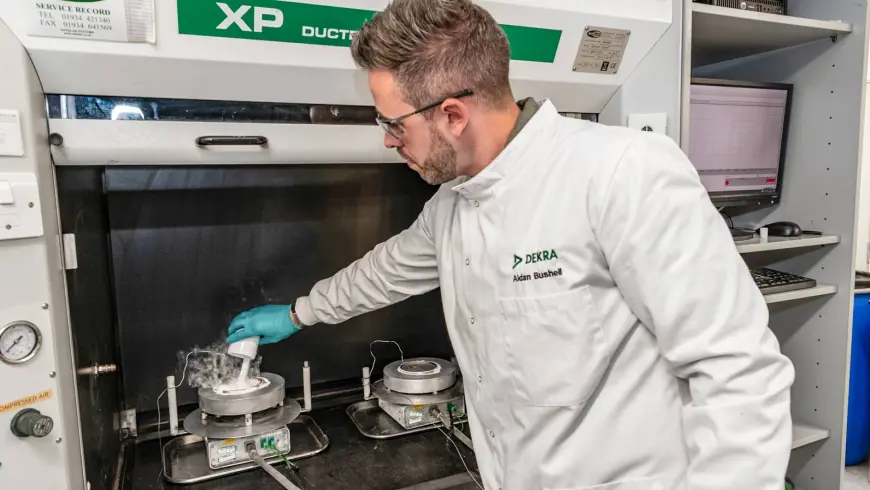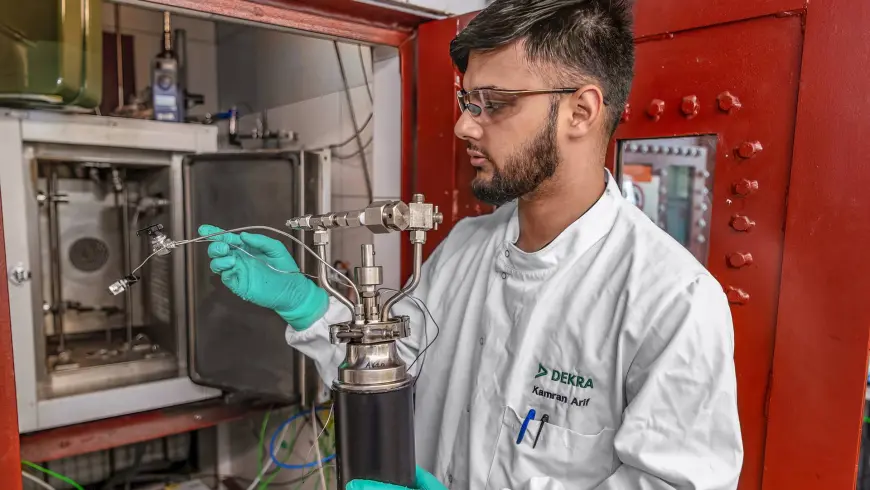Safety in the laboratory KABOOM!
Wherever hazardous substances are processed on an industrial scale, danger is imminent. The colleagues at DEKRA Process Safety near Southampton advise companies on how to prevent or at least control them.
According to estimates by the ILO (International Labour Organization) accidents involving chemicals, fires, and even dust explosions cause more than 650,000 deaths in factories worldwide every year. "Wherever there is a flammable atmosphere, i.e. the presence of hybrid mixtures, of combustible dust, gas or vapour, oxygen and an ignition source, this can happen," explains Aidan Bushell (33), head of DEKRA's Industrial Explosions and Hazards Laboratory (IEH) in Southampton. His job mainly consists of playing out these worst-case scenarios for customers.
"Here in the dust explosion laboratory (ATEX), we focus on the material itself, i.e. how ignition sensitive the dust is and how violent the explosion would be. In general, the finer the dust is and how violent the explosion would be. But the water content and shape of the particles are also important, as these factors can dramatically impact the dust-cloud formation and explosion properties. We identify any potential ignition sources the client may have throughout their process and assess the materials against them. The most prevalent potential ignition source is sparks from electrostatic charging. This is because any form of movement (friction) will generate charge, making electrostatic sparks practically impossible to remove from a plant process."
Process safety in the pharmaceutical and chemical industry
Aidan Bushell's team replicates the conditions in customers’ factories in the food, pharmaceutical, and fertilizer manufacturing sectors, only on a smaller scale. That way, future accidents can either be avoided altogether or at least their impact minimized. "To do this, we try to determine the ignition point of a substance-plus-air mixture under the most conservative conditions within our test setups. This is the only way we can make a statement about when, for example, the energy supply or the supply of oxygen should be throttled back in order to avoid that situation arising in the first place under real conditions."
In the industrial area of the small town of Chilworth, in the so-called Science Park, DEKRA not only operates the dust explosion laboratory, but also a laboratory for electrostatics and the chemical reaction hazards (CRH) laboratory. In total, around 50 colleagues at the site are involved in averting hazards for workers and entire communities. This is because accidents in industrial plants can have serious consequences not only for employees but also for the environment
Safe work in the DEKRA laboratory
Kamran Arif is a member of the Chemical Process Evaluation (CPE) team. The 25-year-old's job is to simulate dangerous – and, of course unintended – reactions of chemical substances with each other. "The focus of my job is always to consider what could potentially go wrong for the customer? For example, if two chemicals were mixed in a production process and a worker forgot to add a chemical. Then he might try to add this chemical more quickly than usual to conceal his mistake. Already the reaction would proceed differently than intended; too much pressure would build up too quickly in the container, and the excess pressure would no longer be able to escape. Not a good mixture."
How dangerous is the job actually for the DEKRA colleagues? Kamran: “What we test is dangerous, of course. But we have a controlled environment here in the lab. All dangerous tests take place in a concrete enclosure made of bulletproof glass, reinforced with plates made of eight-millimeter stainless steel. We have automatic venting and special software that monitors the pressures that are generated: and even if things do go haywire, multiple levels of safety are built in, such as pressure relief valves, and blast panels. In addition, we are equipped with personal protective equipment that far exceeds the legal requirements. So if anyone is safe, it’s us.”
Dust explosion laboratory – from tests to expert opinion
Emily Elliot, 28, is a safety engineer who interfaces with customers for Kamran and Aidan. Right now, she handles both dust explosion customers and those who have a problem with dangerous reactions from chemicals. “Eventually, I’m sure I’ll specialize in one or the other. But right now, I find both issues interesting.”
She switched to DEKRA around four years ago and has never regretted the move, on the contrary: “No two projects are the same because no two companies are the same,” she says enthusiastically. The motivation for coming to DEKRA for advice also varies, she says: “Some companies contact us because they themselves have come to the conclusion that something needs to change. Be it because there have been accidents in comparable factories or because they have been approached internally or externally about grievances. Others are actually already in a good position and want to get better.
Emily Elliot first determines the risks by reviewing the processing material and mixture production. On-site, she works closely with customers, for example on a huge reactor for the pharmaceutical or chemical industry. “I then ask what would happen if you forgot to add water, or if you added too much of this or that substance, or if someone pressed the wrong button.” Tests are then carried out in DEKRA’s laboratories, and colleagues like Aidan and Kamran record the scenario and run it on a small scale. The extrapolation to the actual dose forms the basis for the expert report. In it, the expert suggests safety measures.
Security as a result of work
Emily and her colleagues help avert danger with their work. A good feeling, right? “I actually rarely think about that question because I see safety as a result of my work,” she says. “But actually, this job gives you something like purpose and integrity. You’re always pushing for the right answer, even if the customer isn’t necessarily doing the same.” Lab manager Aidan Bushell also feels this satisfaction: “That’s actually one of the perks of my job. I’m helping people to get home safely from work in the evening.”
Kamran Arif adds: „It’s actually a very good feeling. On the one hand, you must always emphasize how dangerous some procedures and processes are. But at the same time, you offer a solution. You tell people to take such and such protective measures and that this will save lives.” Or, in the words of Stephen Rowe, Managing Director of DEKRA Organisation and Process Safety, “The irony of what we do is that if we do our job right, nothing happens. The company just keeps manufacturing. We’re dealing with events that are extremely unlikely but can have extremely severe consequences.”
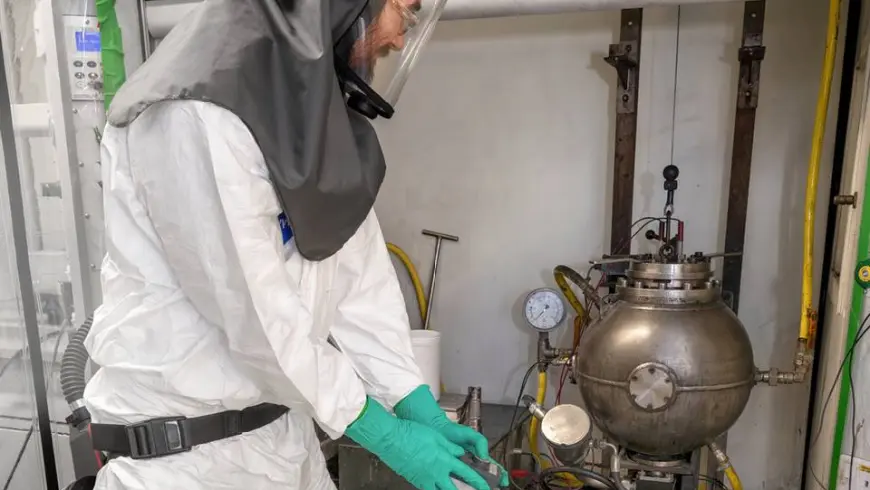

I see safety as a result of my work.
Emily Elliot, Process Safety Specialist at DEKRA
